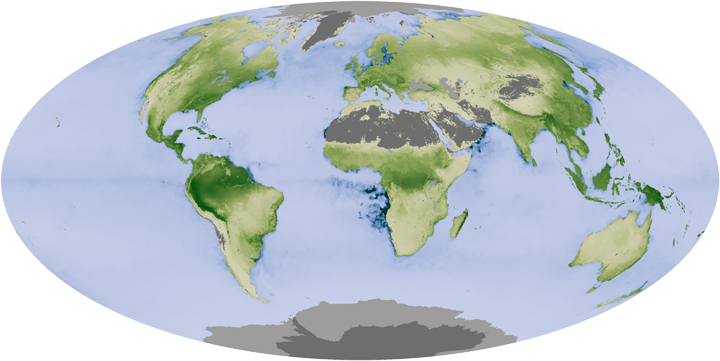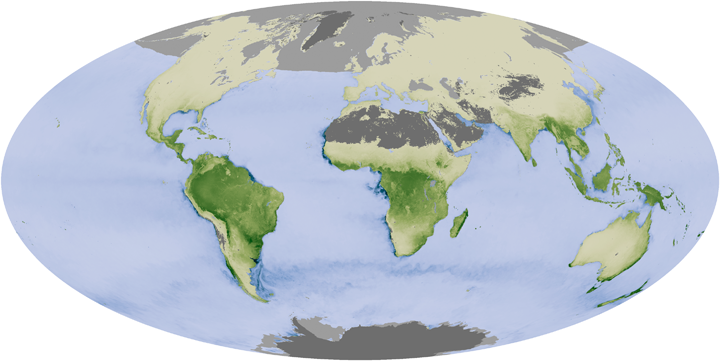NASA: A Global Garden: Plants Storing Carbon - Un Jardin Glogal: Plantas Almacenando Carbono
Posted by Ricardo Marcenaro | Posted in NASA: A Global Garden: Plants Storing Carbon - Un Jardin Glogal: Plantas Almacenando Carbono | Posted on 18:24
acquired August 1 - 31, 2010
Plants breathe. They take carbon dioxide from the atmosphere and turn it into the sugars that become leaves, stems, roots, and woody trunks. What carbon dioxide they don’t use, they exhale, releasing the leftover gas with oxygen. And after plants die, they decay, releasing the carbon to the atmosphere. The difference between the amount of carbon plants absorb and what they release is called net primary productivity. It is a direct measurement of how much plant matter—from crops to forests or ocean phytoplankton—Earth produces.
The amount of carbon plants store varies from month to month with the seasons, as shown in these two images. During spring and summer, plants flourish in the warm temperatures and abundant light. Growth drops off in the winter, when cold and darkness reign.
The top image shows net primary productivity in August 2010, when the Northern Hemisphere reached its peak productivity. On land, areas where plants are growing most—and storing the most carbon—are dark green. Highly productive areas in the ocean, where the most phytoplankton are growing, are dark blue. Because the bulk of Earth’s land is in the Northern Hemisphere, August is also when global net primary productivity reaches a peak.
The lower image shows December 2010, during the Southern Hemisphere’s summer and the Northern Hemisphere’s winter. Globally, plant production is at its lowest during December. This means that plants are taking less carbon dioxide from the atmosphere in December than in other months, and atmospheric concentrations of carbon dioxide peak.
The maps above were made from measurements taken by the Moderate Resolution Imaging Spectroradiometer (MODIS) on the Terra satellite. Such measurements are crucial in helping scientists track what happens to the carbon people release into the atmosphere by burning fossil fuels, as described in our new carbon cycle article:
The amount of carbon plants store varies from month to month with the seasons, as shown in these two images. During spring and summer, plants flourish in the warm temperatures and abundant light. Growth drops off in the winter, when cold and darkness reign.
The top image shows net primary productivity in August 2010, when the Northern Hemisphere reached its peak productivity. On land, areas where plants are growing most—and storing the most carbon—are dark green. Highly productive areas in the ocean, where the most phytoplankton are growing, are dark blue. Because the bulk of Earth’s land is in the Northern Hemisphere, August is also when global net primary productivity reaches a peak.
The lower image shows December 2010, during the Southern Hemisphere’s summer and the Northern Hemisphere’s winter. Globally, plant production is at its lowest during December. This means that plants are taking less carbon dioxide from the atmosphere in December than in other months, and atmospheric concentrations of carbon dioxide peak.
The maps above were made from measurements taken by the Moderate Resolution Imaging Spectroradiometer (MODIS) on the Terra satellite. Such measurements are crucial in helping scientists track what happens to the carbon people release into the atmosphere by burning fossil fuels, as described in our new carbon cycle article:
Plants on land have taken up approximately 25 percent of the carbon dioxide that humans have put into the atmosphere. The amount of carbon that plants take up varies greatly from year to year, but in general, the world’s plants have increased the amount of carbon dioxide they absorb since 1960.Read more in The Carbon Cycle on the Earth Observatory.
With more atmospheric carbon dioxide available to convert to plant matter in photosynthesis, plants were able to grow more. This increased growth is referred to as carbon fertilization....There is a limit to how much carbon plants can take out of the atmosphere, and that limit varies from region to region. So far, it appears that carbon dioxide fertilization increases plant growth until the plant reaches a limit in the amount of water or nitrogen available.
Carbon dioxide also increases temperatures, extending the growing season and increasing humidity. Both factors have led to some additional plant growth. However, warmer temperatures also stress plants. With a longer, warmer growing season, plants need more water to survive. Scientists are already seeing evidence that plants in the Northern Hemisphere slow their growth in the summer because of warm temperatures and water shortages.
NASA Earth Observatory images by Robert Simmon and Reto Stöckli using MODIS data. Caption by Holli Riebeek.
- Instrument:
- Terra - MODIS
Open your mind, your heart to other cultures
Abra su mente, su corazón a otras culturas
You will be a better person
Usted será una mejor persona
RM
Abra su mente, su corazón a otras culturas
You will be a better person
Usted será una mejor persona
RM
You have an alphabetical guide in the foot of the page in the blog: solitary dog sculptorIn the blog: Solitary Dog Sculptor I, the alphabetical guide is on the right side of the pageThanks
Usted tiene una guía alfabética al pie de la página en el blog: solitary dog sculptorEn el blog: Solitary Dog Sculptor I, la guia alfabética está en el costado derecho de la páginaGracias
Usted tiene una guía alfabética al pie de la página en el blog: solitary dog sculptorEn el blog: Solitary Dog Sculptor I, la guia alfabética está en el costado derecho de la páginaGracias
Ricardo M Marcenaro - Facebook
Blogs in operation of The Solitary Dog:
solitary dog sculptor:
http://byricardomarcenaro.blogspot.com
Solitary Dog Sculptor I:
http://byricardomarcenaroi.blogspot.com
Para:
comunicarse conmigo,
enviar materiales para publicar,
propuestas comerciales:
marcenaroescultor@gmail.com
For:
contact me,
submit materials for publication,
commercial proposals:
marcenaroescultor@gmail.com
Diario La Nación
Argentina
Cuenta Comentarista en el Foro:
Capiscum
My blogs are an open house to all cultures, religions and countries. Be a follower if you like it, with this action you are building a new culture of tolerance, open mind and heart for peace, love and human respect.
Thanks :)
Mis blogs son una casa abierta a todas las culturas, religiones y países. Se un seguidor si quieres, con esta acción usted está construyendo una nueva cultura de la tolerancia, la mente y el corazón abiertos para la paz, el amor y el respeto humano.
Gracias :)
NASA: A Global Garden: Plants Storing Carbon - Un Jardin Glogal: Plantas Almacenando Carbono




Comments (0)
Publicar un comentario